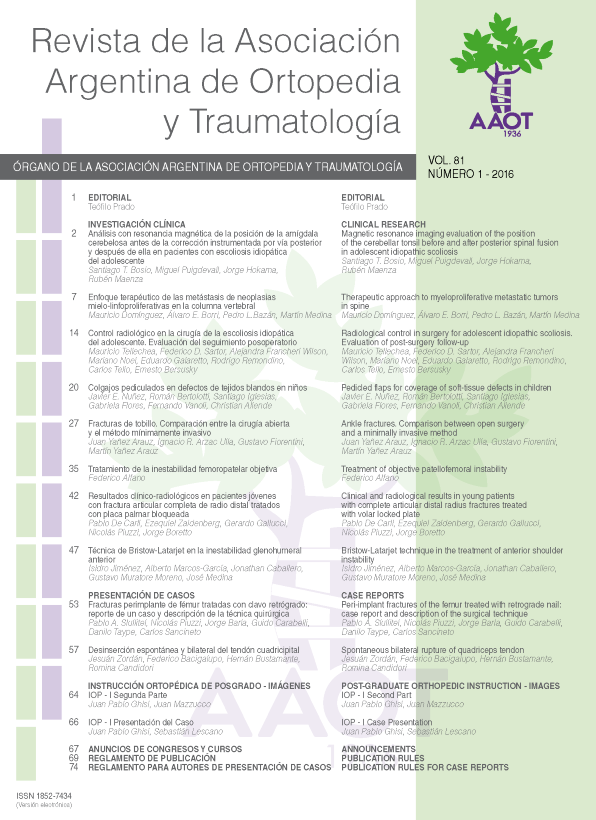Fracturas de tobillo Comparación entre la cirugía abierta y el método mínimamente invasivo. [Ankle fractures. Comparison between open surgery and a minimally invasive method].
Contenido principal del artículo
Resumen
Descargas
Métricas
Detalles del artículo

Esta obra está bajo licencia internacional Creative Commons Reconocimiento-NoComercial-CompartirIgual 4.0.
La aceptación del manuscrito por parte de la revista implica la no presentación simultánea a otras revistas u órganos editoriales. La RAAOT se encuentra bajo la licencia Creative Commons 4.0. Atribución-NoComercial-CompartirIgual (http://creativecommons.org/licenses/by-nc-sa/4.0/deed.es). Se puede compartir, copiar, distribuir, alterar, transformar, generar una obra derivada, ejecutar y comunicar públicamente la obra, siempre que: a) se cite la autoría y la fuente original de su publicación (revista, editorial y URL de la obra); b) no se usen para fines comerciales; c) se mantengan los mismos términos de la licencia.
En caso de que el manuscrito sea aprobado para su próxima publicación, los autores conservan los derechos de autor y cederán a la revista los derechos de la publicación, edición, reproducción, distribución, exhibición y comunicación a nivel nacional e internacional en las diferentes bases de datos, repositorios y portales.
Se deja constancia que el referido artículo es inédito y que no está en espera de impresión en alguna otra publicación nacional o extranjera.
Por la presente, acepta/n las modificaciones que sean necesarias, sugeridas en la revisión por los pares (referato), para adaptar el trabajo al estilo y modalidad de publicación de la Revista.
Citas
2. Garrigues G, Glisson R. Can locking screws allow smaller, low-profile plates to achieve comparable stability to larger, standard plates? J Orthop Trauma 2011;25(6):347-54.
3. Hughes JL, Weber H, Willenegger H, Kuner EH. Evaluation of ankle fractures: non-operative and operative treatment. Clin Orthop Rel Res 1979;138:111-9.
4. Minihane K, Lee C, Ahn C. Comparison of lateral locking plate and antiglade plate for fixation of distal fibular fractures in osteoporotic bone. A biomechanical study. J Orthop Trauma 2006;20(8):562-6.
5. Stufkens S,Van den Bekerom M, Kerkhoffs G. Long term outcome after 1822 operatively treated ankle fractures: A systematic review of the literature. Injury-Int J Care Injured 2011;42:119-27.
6. Yablon IG, Heller FG, Shouse L. The key role of the lateral malleolus in displaced fractures of the ankle. J Bone Joint Surg Am 1977;59:169-73.
7. Hess F, Sommer C. Minimally invasive plate osteosynthesis of the distal fibula with the locking compression plate: First experience of 20 cases. J Orthop Trauma 2011;25:110-5.
8. Bloomstein L, Schenk R, Grob P. Percutaneous plating of periarticular tibial fractures: a reliable, reproducible technique for controlling plate passage and positioning. J Orthop Trauma 2008;22(8):566-71.
9. Collinge C, Sanders R, DiPasquale, T. Treatment of complex tibial periarticular fractures using percutaneous techniques. Clin Orthop Relat Res 2000;375:69-77.
10. Ozkaya U, Parmaksizoglu A, Gul M. Minimally invasive treatment of distal tibial fractures with locking and non locking plates. Foot Ankle Int 2009;30(12):1161-7.
11. Ruedi TP, Buckley RE, Morgan CG. AO Principles of fracture management. Pathophysiology, evaluation, and classification of fractures; AO Foundation Publishing; 2007.
12. Tornkvist H, Hearn TC, Schatzker J. The strength of plate fixation in relation to number and spacing of bone screws. J Orthop Trauma 1996;10(3):204-8.
13. Yañez Arauz JM. Osteosíntesis mínimamente invasiva en fracturas del peroné distal. Rev Asoc Argent Ortop Traumatol 2005;70(2):136-45.
14. Bauer M, Bengner U, Johnell O, Redlund Johnell I. Supination-eversion fractures of the ankle joint: changes in incidence over 30 years. Foot Ankle 1987;8(1):26-8.
15. Hahn DM, Colton CL. Malleoli. En: Ruedi TP, Buckley RE (eds). AO Principles of fracture management, 2nd ed. New York: AO Publishing, Thieme; 2007:870-97.
16. Chapman MW. Fracture and fracture dislocation of the ankle. En: Mann RA, Coughlin MJ. Surgery of the foot and ankle, 6th ed. St Louis: Mosby; 1993:1464-93.
17. Burwell HN, Charnley AD. The treatment of displaced fractures at the ankle by rigid internal fixation and early joint movement. J Bone Joint Surg Br 1965;47:634-60.
18. Farouk O, Krettek C, Miclau T, Schandelmaier P, Guy P, Tscherne H. Minimally invasive plate osteosynthesis and vascularity: preliminary results of a cadaver injection study. Injury 1997;28(Suppl 1):A7-A12.
19. Rhinelander FW. The normal microcirculation of diaphyseal cortex and its response to fracture. J Bone Joint Surg Am 1968;50784-800.
20. Robinson CM, McLaughlan GJ, McLean IP, Court-Brown CM. Distal metaphyseal fractures of the tibia with minimal involvement of the ankle. Classification and treatment by locked intramedullary nailing. J Bone Joint Surg 1995;77(5):781-7.
21. Yañez Arauz JM. Osteosíntesis mínimamente invasiva del maléolo peróneo. Flamecipp 2012;2(1):37-46.
22. Fink B, Mizel MS. What’s news in foot and ankle surgery? J Bone Joint Surg Am 2002;84(3):504-9.
23. Shah NH, Sundaram RO, Velusamy A, Braithwaite IJ. Five year functional outcome analysis of ankle fracture fixation. Injury 2007;38:1308-12.
24. Colvin AC, Walsh M, Koval KJ, Mc Laurin T, Tejwani N, Egol K. Return to sports following operatively treated ankle fractures. Foot Ankle Int 2009;30(4):292-6.
25. Kennedy JG, Johnson SM, Collins SL, Dallo Vedova P, Mc Manus WF, Hynes DM, et al. An evaluation of the Weber classification of ankle fractures. Injury 1998;29:557-80.
26. Tejwani NC, Mc Laurin TM, Walsh M, Bhadsavle, Koval K, Egol K. Are outcomes of bimalleolar fractures poorer than those of lateral maleolar fractures with medial ligament injury? J Bone Joint Surg Am 2007;89:1438-41.
27. Khurana S, Raj Karia, Kenneth A. Operative treatment of no union following distal fibula and medial maleolar ankle fractures. Foot Ankle Int 2013;34(3):365

